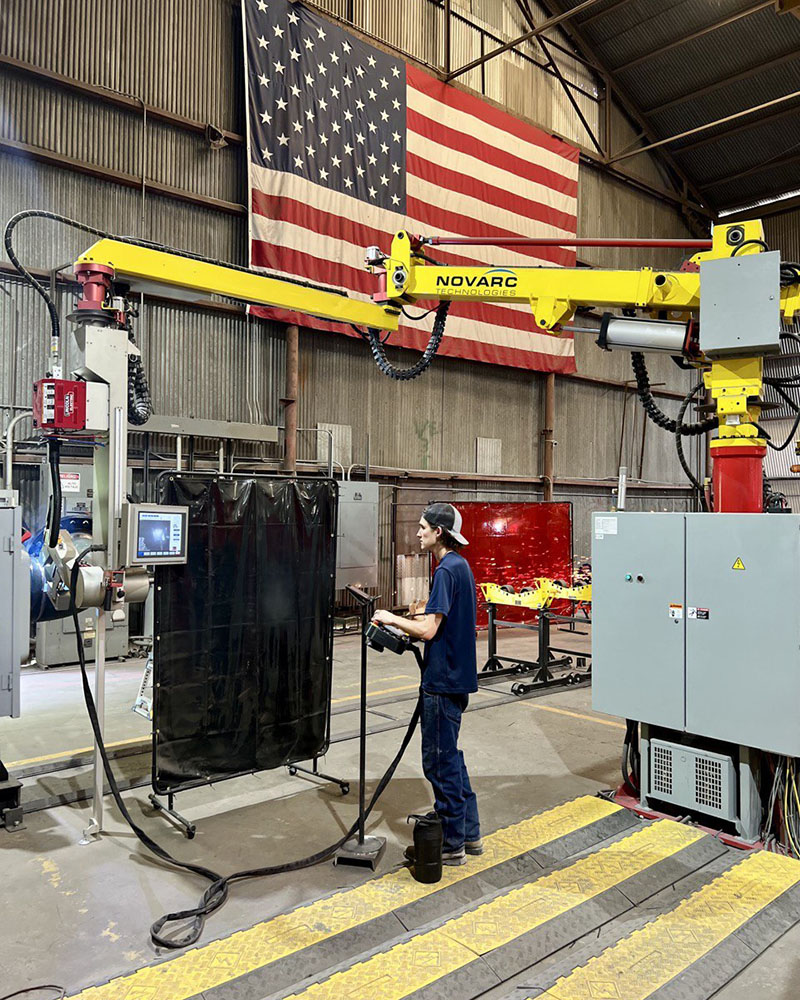This is an excerpt from Tube and Pipe Journal written by Debra Hadden
Cobot helps manufacturer increase productivity for multiple applications
For Joe White Tank in Fort Worth, Texas, increased demand for construction projects—and more competitive bidding for the pipe fabrication jobs within those projects—recently presented a new challenge.
The company has been in the welding industry since 1942, specializing in fabricating custom tanks, pressure vessels for industrial and ammonia refrigeration, and piping for commercial and industrial construction. It has built a reputation for quality work while consistently delivering products faster than typical market lead times.
That standard recently got put to the test, but President Jeff Yurtin and his management team aren’t people used to resting on their laurels. Rather, they’re normally on the hunt for new ways to clear the next hurdle.
The Cobot Solution
For Yurtin, the issue at hand was scaling labor for projects that can dampen productivity if they’re not managed correctly. To meet that need, he chose to invest in a Novarc Spool Welding Robot (SWR). The machine offers accurate torch control and machine learning algorithms that can detect different features of a workpiece.
The unit was designed specifically for pipes, pressure vessels, and other types of roll-welded workpieces. It features an adaptive controls system to help ensure accurate torch control, and AI/machine learning algorithms to detect weld pool features.
The SWR can integrate smoothly with the production flow and existing manufacturing processes of customers, according to Soroush Karimzadeh, Novarc’s co-founder and CEO.
“The SWR is designed with a small footprint and a very long reach, enabling it to be adopted in almost any fabrication shop, no matter the layout or various requirements,” Karimzadeh said. “It’s designed to be minimally intrusive to the production flow.”
The nature of Joe White Tank’s bread-and-butter projects can throw a kink into its work process, however. And that includes persistent labor issues.
“Piping projects can require hard starts and stops with little time to ramp your labor up and down,” Yurtin said. “Hiring and firing welders for jobs was not our idea of success. We pursued growing our business with a long-term mindset. By adding the SWR to our shop floor, we added capacity strategically and avoided many of the negative implications that come from a short-term, job-to-job labor force. And it has a small footprint; we would have had to install four manual weld cells to do the job of the SWR.”
Addressing Labor Shortages
The SWR also helps to address the nationwide shortage of skilled welders by helping less-experienced operators produce high-quality welds.
“Balancing a stable workforce with changing customer and industry demands can be difficult,” Yurtin said. “Our organization’s culture is very important to our management team. So, as we have grown our company’s market presence, we have worked to limit high employee turnover.”
The benefits of workforce continuity are legion. Not only does it give employees a greater sense of job security, but it also results in a more willing commitment to corporate goals. At a time when fabrication shops across North America are experiencing a shortage of skilled welders, “the SWR helped limit the impact of this challenge,” Yurtin said.
“We used to have a department dedicated to pipe welding, but now we have our SWR operators working with fitters, supporting them, to ramp up efficiency,” he said. “This has freed up welders to work on other projects in our backlog, shrinking our market lead time and significantly increasing our capacity. The Novarc SWR increased our capacity by 400% without reducing quality.”
The SWR accommodates users with a set of requirements for the fit-up process and provides comprehensive training for fitters.
“This is another way to ensure the integration of the SWR into our clients’ manufacturing processes is as smooth as possible,” Karimzadeh said.
With a nod to sustaining their strong corporate culture, the company’s employees are buying in, according to Yurtin.
“Anyone that’s been in the welding business for more than 10 minutes knows that the physical demands are significant,” Yurtin said. “Welders get tired.
“The ergonomics of the SWR are an immediate benefit for the welder,” he added. “They’re still using their hands, but they don’t have to wear a hood, and it’s much easier with the joystick control.”
